Analysis of the Lake-Effect on Precipitation in the Taihu Lake Basin Based on the GWR Merged Precipitation
Abstract
1. Introduction
2. Study Area and Dataset
2.1. Study Area
2.2. Datasets
3. Methodology
3.1. GWR-Based Rainfall Merging
3.2. Generation of the Benchmark Precipitation
3.3. Precipitation Accuracy Evaluation
3.4. Lake-Effect on Precipitation Diagnosis
4. Results and Discussion
4.1. The Accuracy of Merged Precipitation
4.2. The Spatial Distribution of Precipitation and Its Influencing Factors
4.3. The Effect of the Taihu Lake on Precipitation Spatial Distribution
5. Conclusions
- (1)
- At 0.1° × 0.1° grid scale, GWR merged precipitation has a strong ability to detect the daily precipitation in Taihu Lake Basin from 1979 to 2016, and its accuracy is higher than that of MSWEP V2.1. It has a significant advantage in the analysis of precipitation in Taihu Lake, which can basically restore the actual distribution of precipitation in Taihu Lake. Except for the distribution pattern of more rainfall in the west and less in the east in July, more precipitation is distributed in the southwest and less rainfall is distributed in the middle, east and north areas in Taihu Lake.
- (2)
- The spatial distribution of precipitation under the effect of topography (EOF-1) is the dominant spatial distribution (95% variance contribution rate). It shows a good response relationship with DEM in the southwest rainy mountainous area (r = 0.64), but no significant relationship in the lake upwind area. The phenomenon of lake-effect on precipitation does exist, and the multi-year average precipitation in the lake upwind area is 8.31% less than that in the lake downwind area.
- (3)
- The distribution of precipitation in the southwest mountain rainy area has a higher consistency with climatic factors (|r| > 0.6) than that in the plain area, especially in the lake upwind area. The southeast monsoon is deduced as the most important factor affecting the lake-effect on precipitation. The distribution of wind direction and wind speed determines the dynamic changes of surface water vapor to a certain extent—it brings the wet and hot water vapor in the upwind area to the lake area, and under the further strengthening by the lake, the enhanced wet hot water vapor is carried to the downwind area, which increases the regional precipitation in lake downwind area, while suppressing precipitation in the lake area and upwind area. The lake-effect on precipitation is most evident in July.
- (4)
- Based on the monthly GWRMP and ERA5 meteorological reanalysis data, the possible influence mechanism of lake-effect on precipitation in Taihu Lake region was explored preliminarily at 0.25° × 0.25° grid scale. The research mainly uses the distribution consistency determined by the correlation analysis method as the evaluation metric about the possible influence mechanism. It is only a qualitative analysis not quantitative evaluation on the impact threshold of each meteorological element. Thus, a quantitative study on factors that affect the lake-effect on precipitation should be strengthened by further mathematical models and more detailed meteorological data collection in the Taihu Lake Basin.
Author Contributions
Funding
Acknowledgments
Conflicts of Interest
References
- Eichenlaub, V.L. Lake Effect Snowfall to the Lee of the Great Lakes: Its Role in Michigan. Bull. Am. Meteorol. Soc. 2010, 51, 403–473. [Google Scholar] [CrossRef]
- Burnett, A.W.; Kirby, M.E.; Mullins, H.T.; Patterson, W.P. Increasing Great Lake-effect snowfall during the twentieth century: A regional response to global warming? J. Clim. 2003, 16, 3535–3542. [Google Scholar] [CrossRef]
- Yeager, K.N.; Steenburgh, W.J.; Alcott, T.I. Contributions of Lake-Effect Periods to the Cool-Season Hydroclimate of the Great Salt Lake Basin. J. Appl. Meteorol. Climatol. 2013, 52, 341–362. [Google Scholar] [CrossRef]
- Dai, Y.; Yao, T.; Li, X.; Ping, F. The impact of lake effects on the temporal and spatial distribution of precipitation in the Nam Co basin, Tibetan Plateau. Quat. Int. 2016, 475, 63–69. [Google Scholar] [CrossRef]
- Huffman, G.J.; Bolvin, D.T.; Nelkin, E.J.; Wolff, D.B.; Adler, R.F. The TRMM Multi-satellite Precipitation Analysis (TMPA): Quasi-global, multiyear, combined-sensor precipitation estimates at fine scales. J. Hydrometeorol. 2007, 8, 38–55. [Google Scholar] [CrossRef]
- Tang, G.; Ma, Y.; Long, D. Evaluation of GPM Day-1 IMERG and TMPA Version-7 legacy products over Mainland China at multiple spatiotemporal scales. J. Hydrometeorol. 2016, 533, 152–167. [Google Scholar] [CrossRef]
- Xu, X.; Steven, K.F.; Alaba, B.; Andre, R.E. Evaluation of variability among different precipitation products in the Northern Great Plains. J. Hydrometeorol. 2019, 24. [Google Scholar] [CrossRef]
- Beck, H.E.; van Dijk, T.; Vincenzo, L.; Jaap, S.; Miralles, D.G. MSWEP: 3-hourly 0.25° global gridded precipitation (1979–2015) by merging gauge, satellite, and reanalysis data. Hydrol. Earth Syst. Sci. 2017, 21, 589–615. [Google Scholar] [CrossRef]
- Beck, H.E.; Wood, M.; Pan, C.; Fisher, D.; Miralles, A.; van Dijk, T. MSWEP V2 global 3-hourly 0.1° precipitation: Methodology and quantitative assessment. Bull. Am. Meteorol. Soc. 2019, 3, 437–500. [Google Scholar] [CrossRef]
- Menne, M.J.; Durre, R.S.; Vose, R.S.; Gleason, B.E.; Houston, T.G. An overview of the 954 Global Historical Climatology Network-Daily databases. J. Atmos. Ocean. Technol. 2012, 29, 897–910. [Google Scholar] [CrossRef]
- Schneider, U.; Becker, A.; Finger, P.; Christoffer, A.M. GPCC’s new land surface precipitation climatology based on quality-controlled in situ data and its role in quantifying the global water cycle. Theor. Appl. Climatol. 2014, 115, 15–40. [Google Scholar] [CrossRef]
- Schneider, U.; Finger, P.; Becker, A. Meyer-Christoffer. Evaluating the hydrological cycle over land using the newly-corrected precipitation climatology from the Global Precipitation Climatology Centre (GPCC). Atmosphere 2017, 8, 52. [Google Scholar] [CrossRef]
- Joyce, R.J.; Janowiak, J.E.; Arkin, P.A.; Xie, P. CMORPH: A method that produces global precipitation estimates from passive microwave and infrared data at high spatial and temporal resolution. J. Hydrometeorol. 2004, 5, 487–503. [Google Scholar] [CrossRef]
- Ushio, T.; Kachi, M. A Kalman filter approach to the Global Satellite Mapping of Precipitation (GSMaP) from combined passive microwave and infrared radiometric data. J. Meteorol. Soc. Jpn. 2009, 87A, 137–151. [Google Scholar] [CrossRef]
- Dee, D.P.; Uppala, S.M.; Simmons, A.J.; Berrisford, P.; Poli, P.; Kobayashi, S. The ERA-Interim reanalysis: Configuration and performance of the data assimilation system. Q. J. R. Meteorol. Soc. Part A 2011, 137, 553–597. [Google Scholar] [CrossRef]
- Knapp, K.R.; Ansari, S.; Bain, C.L.; Bourassa, M.A.; Magnusdottir, G. Globally gridded satellite observations for climate studies. Bull. Am. Meteorol. Soc. 2011, 92, 893–907. [Google Scholar] [CrossRef]
- Kobayashi, S.; Ota, Y.; Harada, Y.; Ebita, A. The JRA-55 reanalysis: General specifications and basic characteristics. J. Meteorol. Soc. Jpn. 2015, 93, 5–48. [Google Scholar] [CrossRef]
- Fick, S.E.; Hijmans, R.J. WorldClim 2: New 1-km spatial resolution climate surfaces for global land areas. Int. J. Climatol. 2017, 37, 4302–4315. [Google Scholar] [CrossRef]
- Villanueva, O.M.B.; Zambrano-Bigiarini, M.; Ribbe, L.; Nauditt, A.; Rebolledo Coy, M.A. Temporal and spatial evaluation of satellite rainfall estimates over different regions in Latin-America. Atmos. Res. 2018, 213, 34–50. [Google Scholar] [CrossRef]
- Awange, J.L.; Hu, K.; Khaki, M. The newly merged satellite remotely sensed, gauge and reanalysis-based Multi-Source Weighted-Ensemble Precipitation: Evaluation over Australia and Africa (1981–2016). Sci. Total Environ. 2019, 670, 448–465. [Google Scholar] [CrossRef]
- Liu, J.; Shangguan, D.; Liu, S. Evaluation and comparison of CHIRPS and MSWEP daily-precipitation products in the Qinghai-Tibet Plateau during the period of 1981–2015. Atmos. Res. 2019, 230, 104634. [Google Scholar] [CrossRef]
- Akhilesh, N.; Indu, J. Performance Assessment of Multi-Source Weighted-Ensemble Precipitation (MSWEP) Product over India. Climate 2017, 5, 2–20. [Google Scholar]
- Alijanian, M.; Rakhshandehroo, G.R.; Mishra, A.K.; Dehghani, M. Evaluation of satellite rainfall climatology using CMORPH, PERSIANN-CDR, PERSIANN, TRMM, MSWEP over Iran. Int. J. Climatol. 2017, 37, 4896–4914. [Google Scholar] [CrossRef]
- Deng, Y.; Jiang, W.; Wang, X.; Lv, J. Accuracy assessment of MSWEP over mainland China. Adv. Water Sci. 2018, 29, 455–464. [Google Scholar]
- Wu, Z.; Xu, Z.; Wang, F.; He, H.; Zhou, J. Hydrologic evaluation of multi-source satellite precipitation products for the Upper Huaihe River Basin, China. Remote Sense 2018, 10, 840. [Google Scholar] [CrossRef]
- Xu, Z.; Wu, Z.; He, H.; Wu, X.; Zhou, J. Evaluating the accuracy of MSWEP V2.1 and its performance for drought monitoring over mainland China. Atmos. Res. 2019, 226, 17–31. [Google Scholar] [CrossRef]
- Hydrological Bureau (Information Center) of Taihu Basin Authority of Water Resources. Annual Report of Water Regime in Taihu Lake Basin; Taihu Basin Authority of Water Resources: Shanghai, China, 2016. [Google Scholar]
- Hu, Q.; Yang, H.; Meng, X.; Wang, Y.; Deng, P. Satellite and gauge rainfall merging using geographically weighted regression. Remote Sens. GIS Hydrol. Water Resour. 2015, 368, 132–137. [Google Scholar] [CrossRef]
- Chao, L.; Zhang, K.; Li, Z.; Zhu, Y.; Wang, J.; Yu, Z. Geographically weighted regression-based methods for merging satellite and gauge precipitation. J. Hydrol. 2018, 558, 275–289. [Google Scholar] [CrossRef]
- Li, L. Precipitation Information Fusion Using Geographically-Temporally Weighted Regression Method and Its Hydrological Application—A Case Study over the Huai River Basin. Master’s Thesis, Nanjing Academy of Water Conservancy Sciences, Nanjing, China, 2018. [Google Scholar]
- Yuan, J. A Research and Application Analysis of Rain Gauge—Satellite Precipitation Data Merging Technique Based on Geographically Weighted Regression Algorithm. Master’s Thesis, Hohai University, Nanjing, China, 2017. [Google Scholar]
- Brunsdon, C.; Fotheringham, S.; Charlton, M. Geographically Weighted Regression. J. R. Stat. Soc. 1998, 47, 431–443. [Google Scholar] [CrossRef]
- Achilleos, G. Errors within the Inverse Distance Weighted (IDW) interpolation procedure. Geocarto Int. 2008, 23, 429–449. [Google Scholar] [CrossRef]
- Hu, Q.; Yang, D.; Wang, Y.; Yang, H.; Liu, Y. Validation and error interpretation for daily TRMM 3B42V6 rainfall over the Ganjiang River basin in China. Adv. Water Sci. 2013, 24, 1–9. [Google Scholar]
- Aghakouchak, A.; Mehran, A. Extended contingency table: Performance metrics for satellite observations and climate model simulations. Water Resour. Res. 2013, 49, 7144–7149. [Google Scholar] [CrossRef]
- Robertson, C.; Long, J.A.; Nathoo, F.S.; Nelson, T.; Plouffe, C.C.F. Assessing quality of spatial models using the structural similarity index and posterior predictive checks. Geogr. Anal. 2014, 46, 53–74. [Google Scholar] [CrossRef]
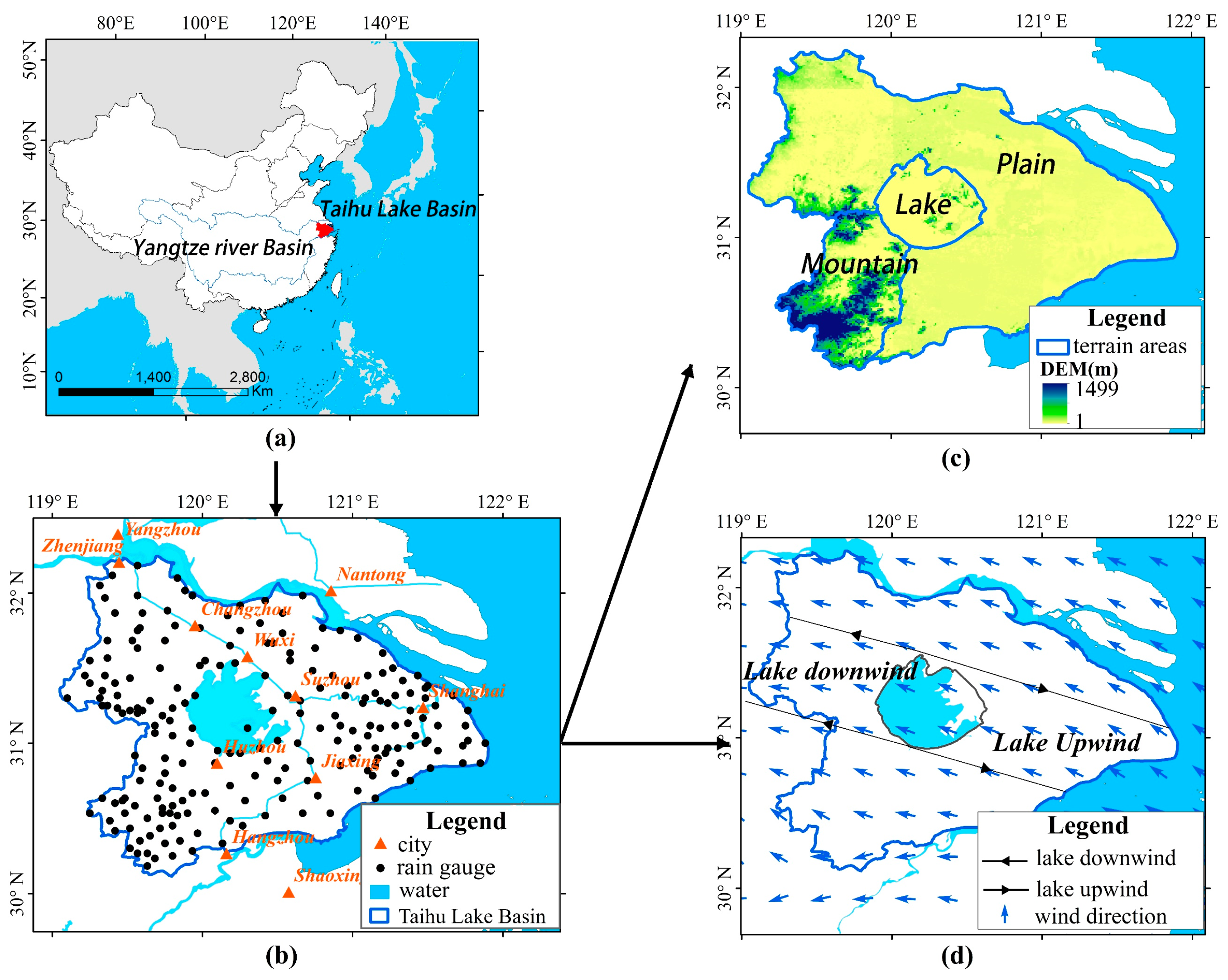
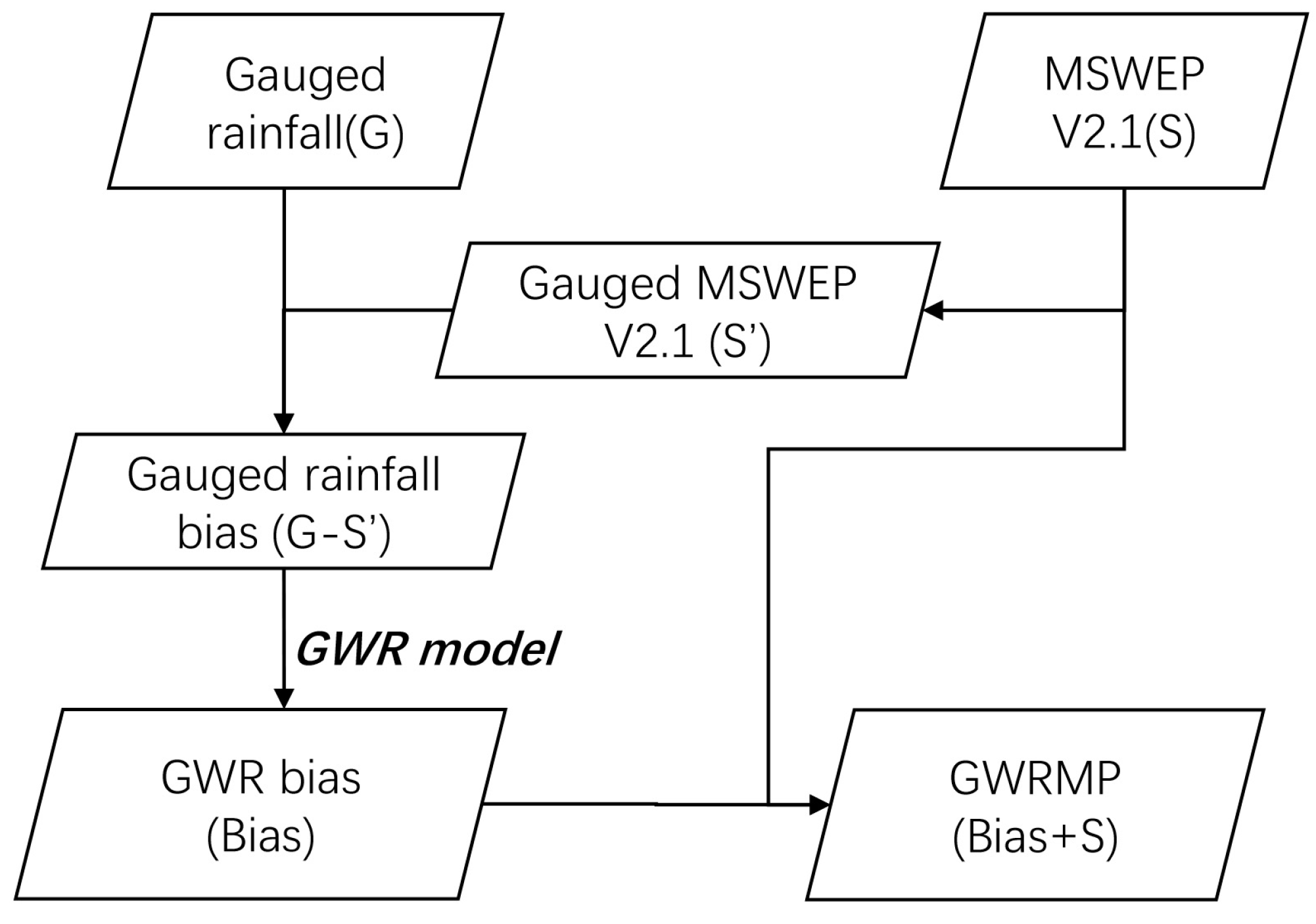
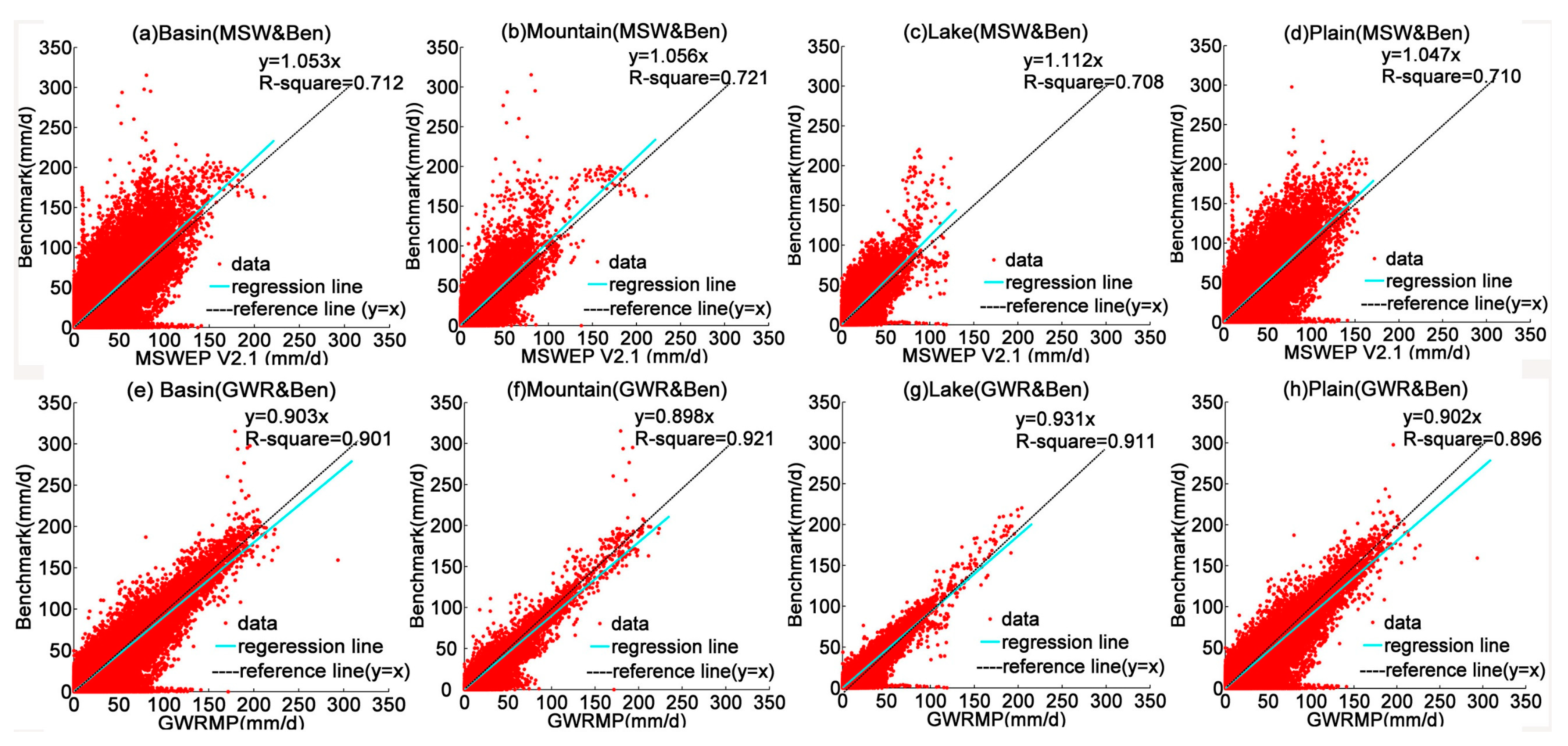

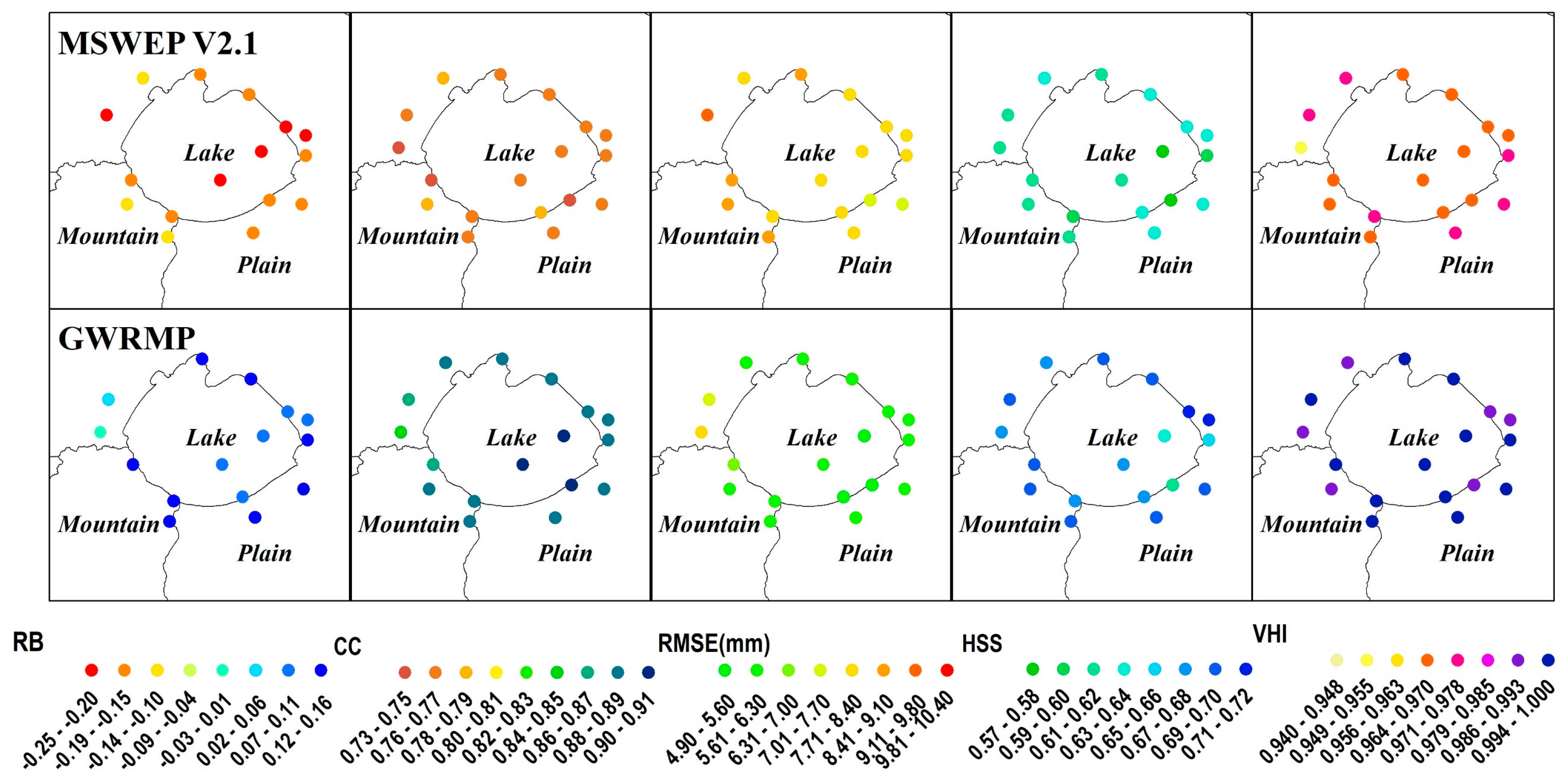
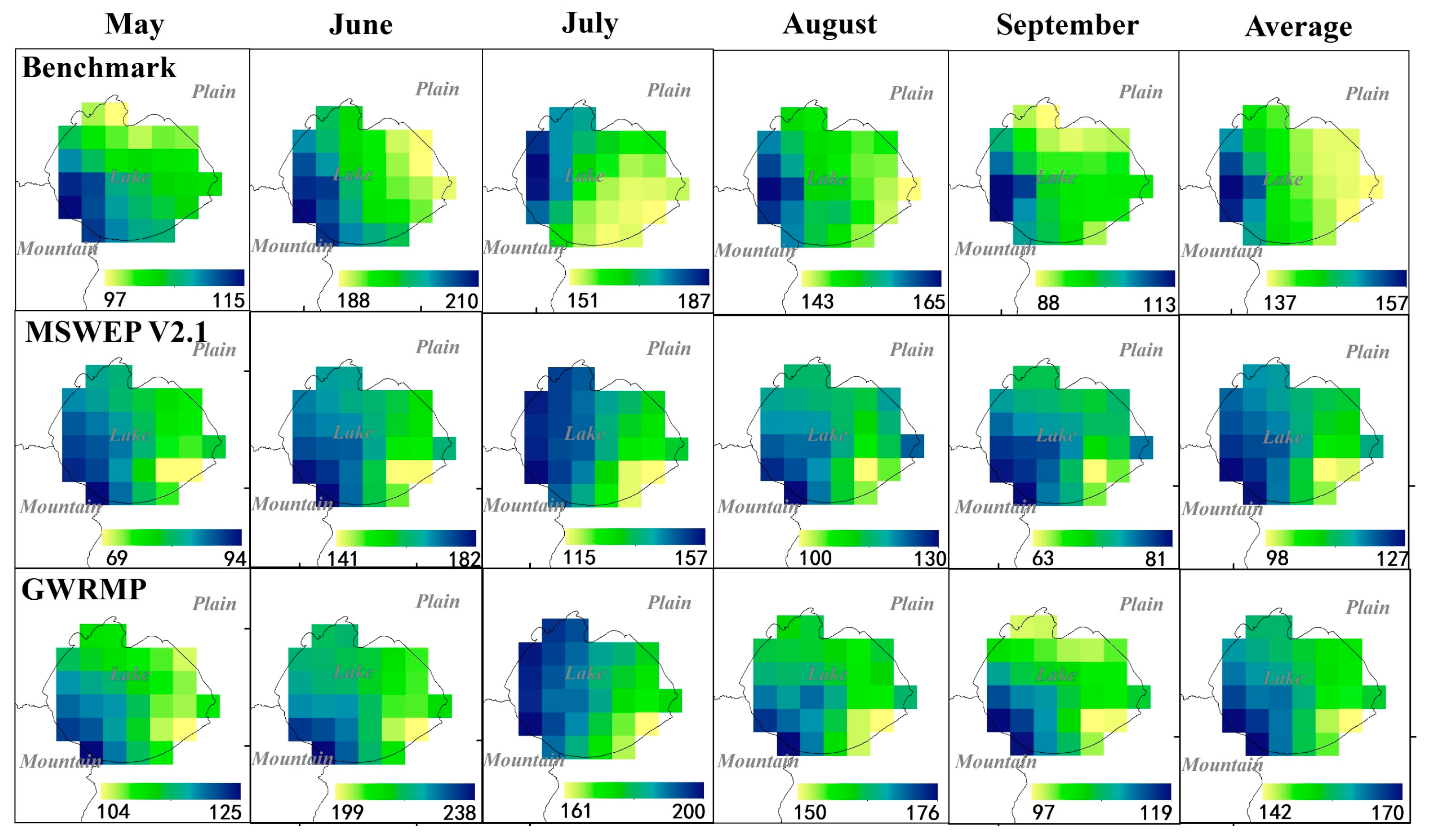
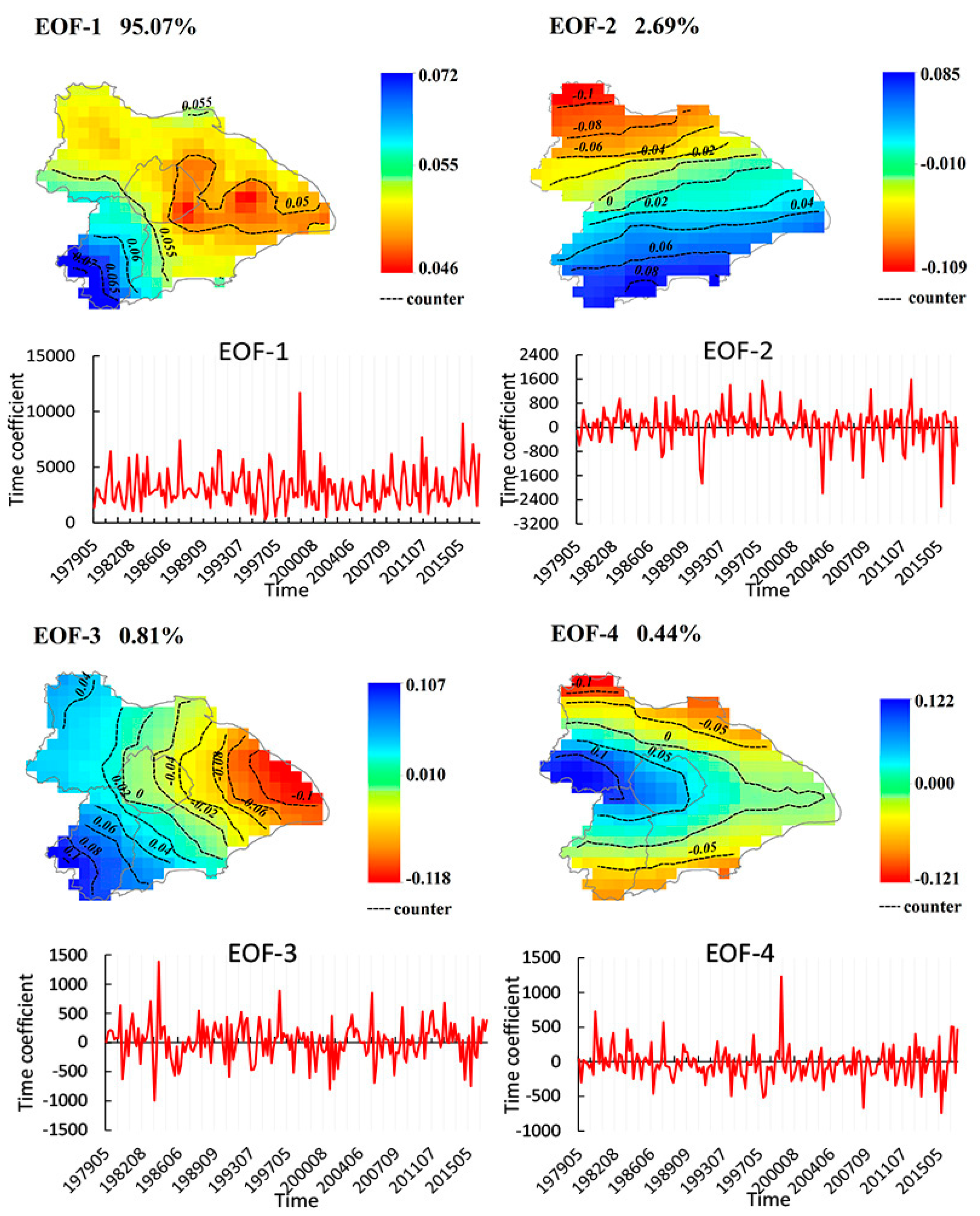
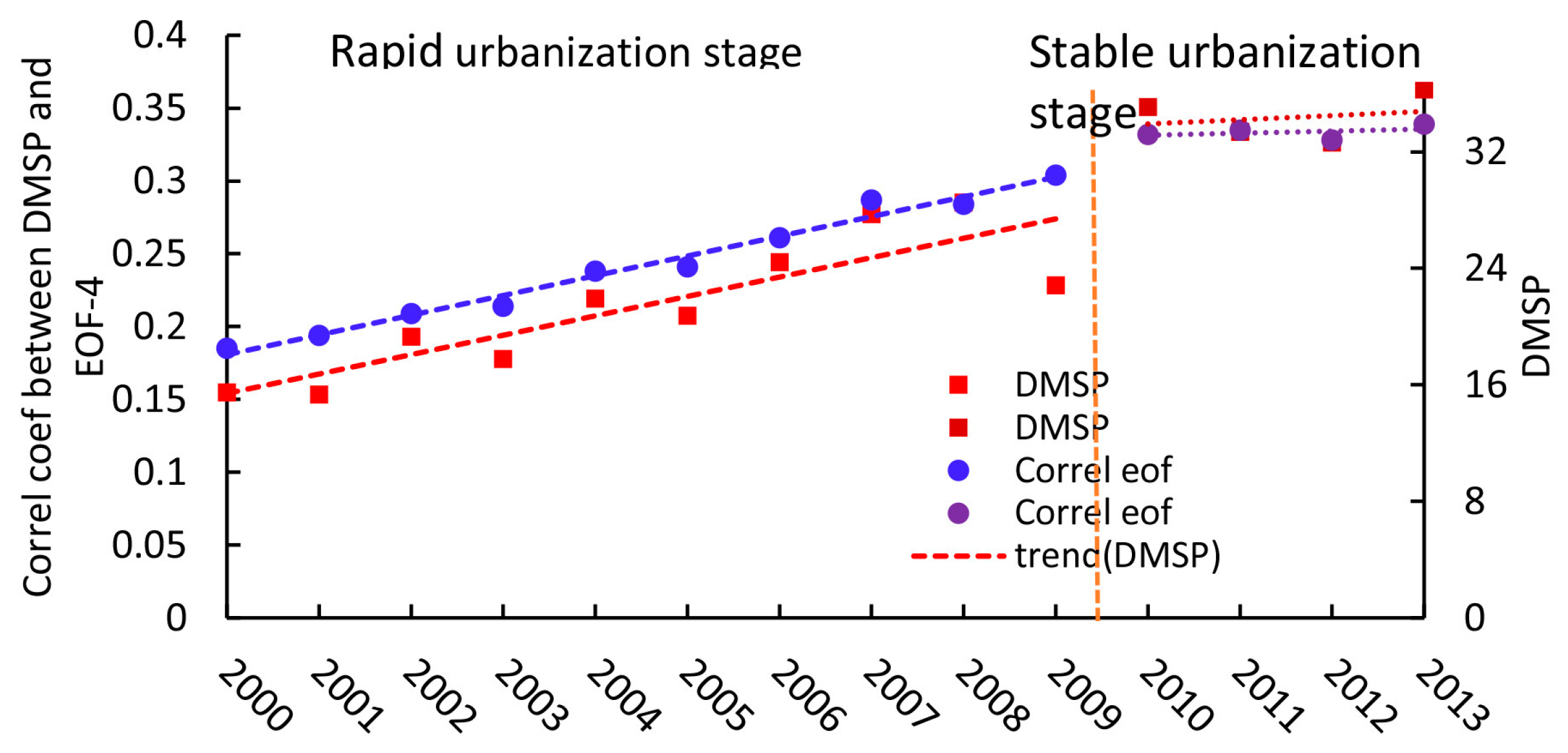
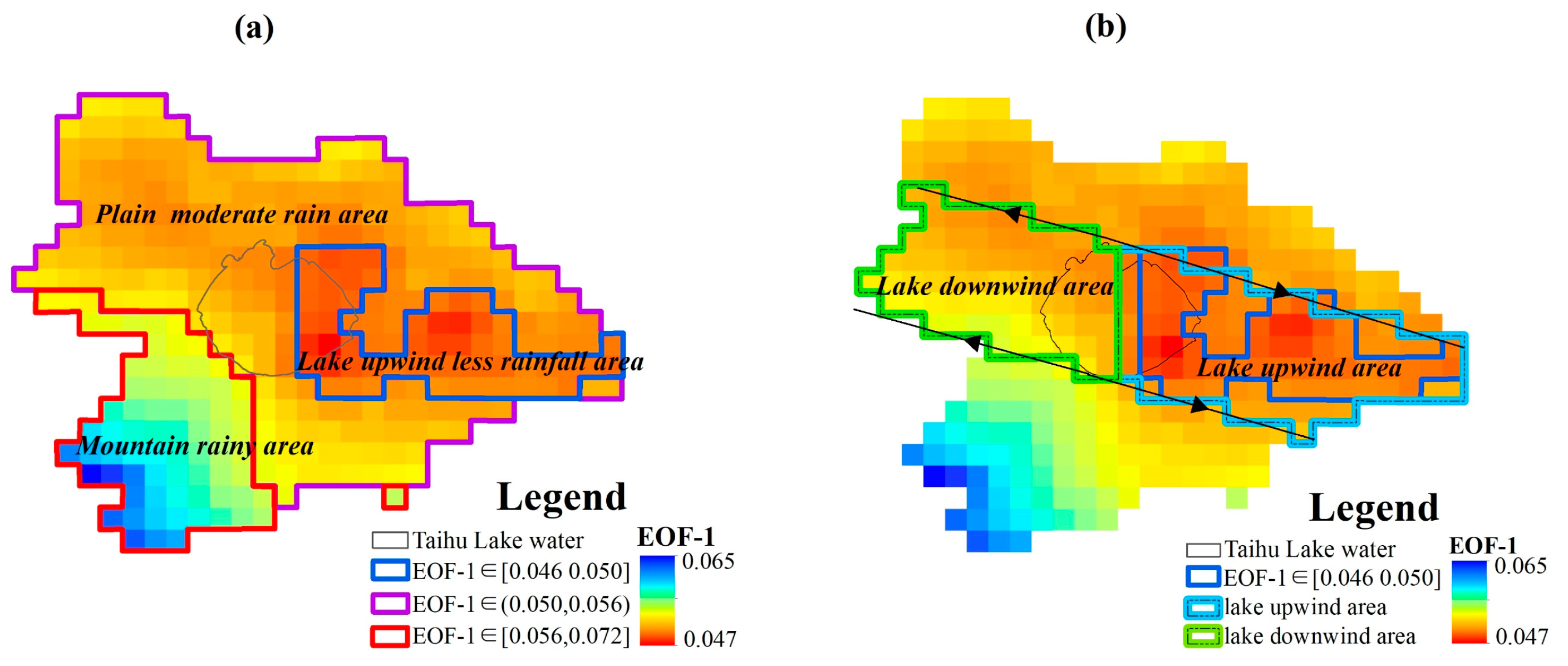
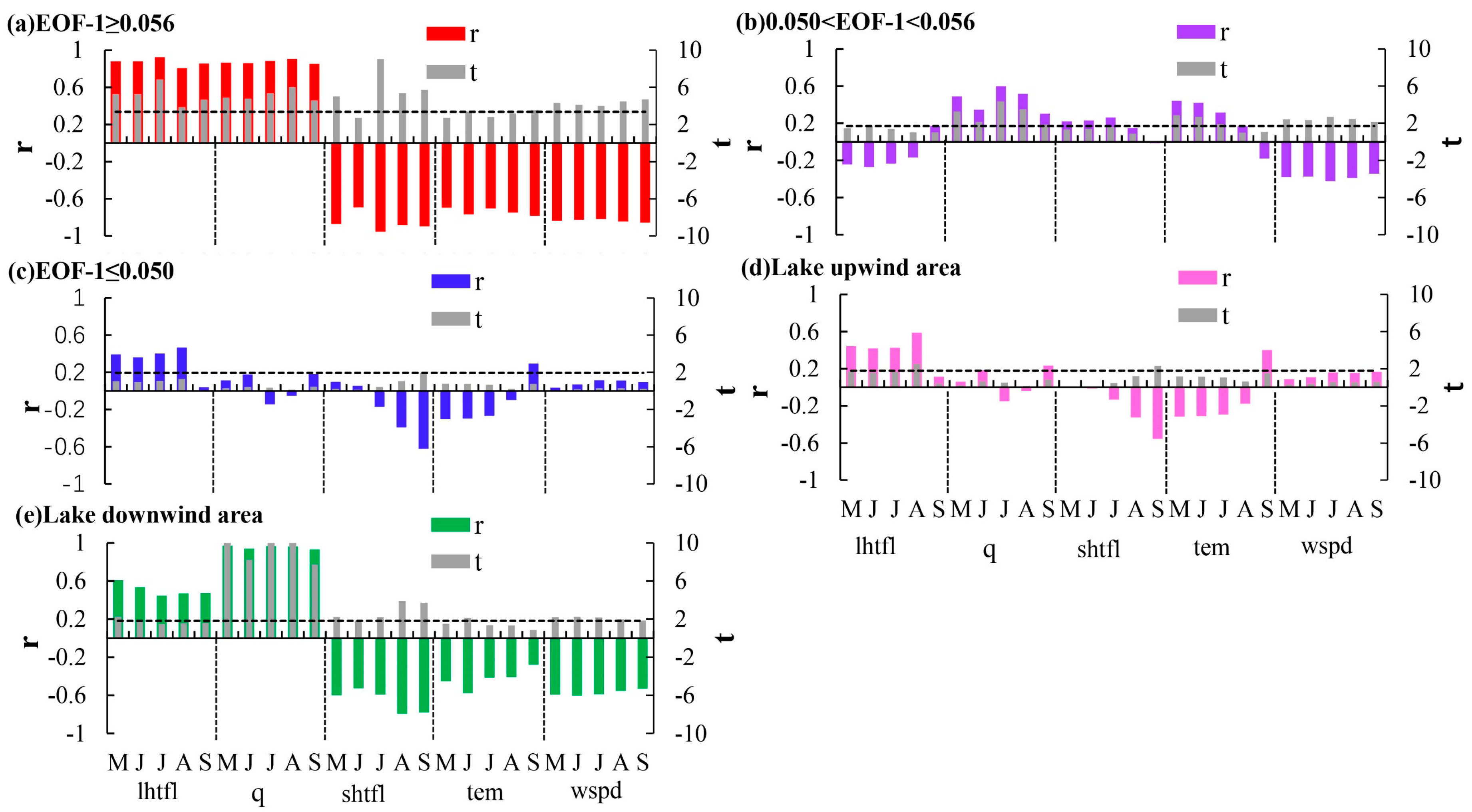

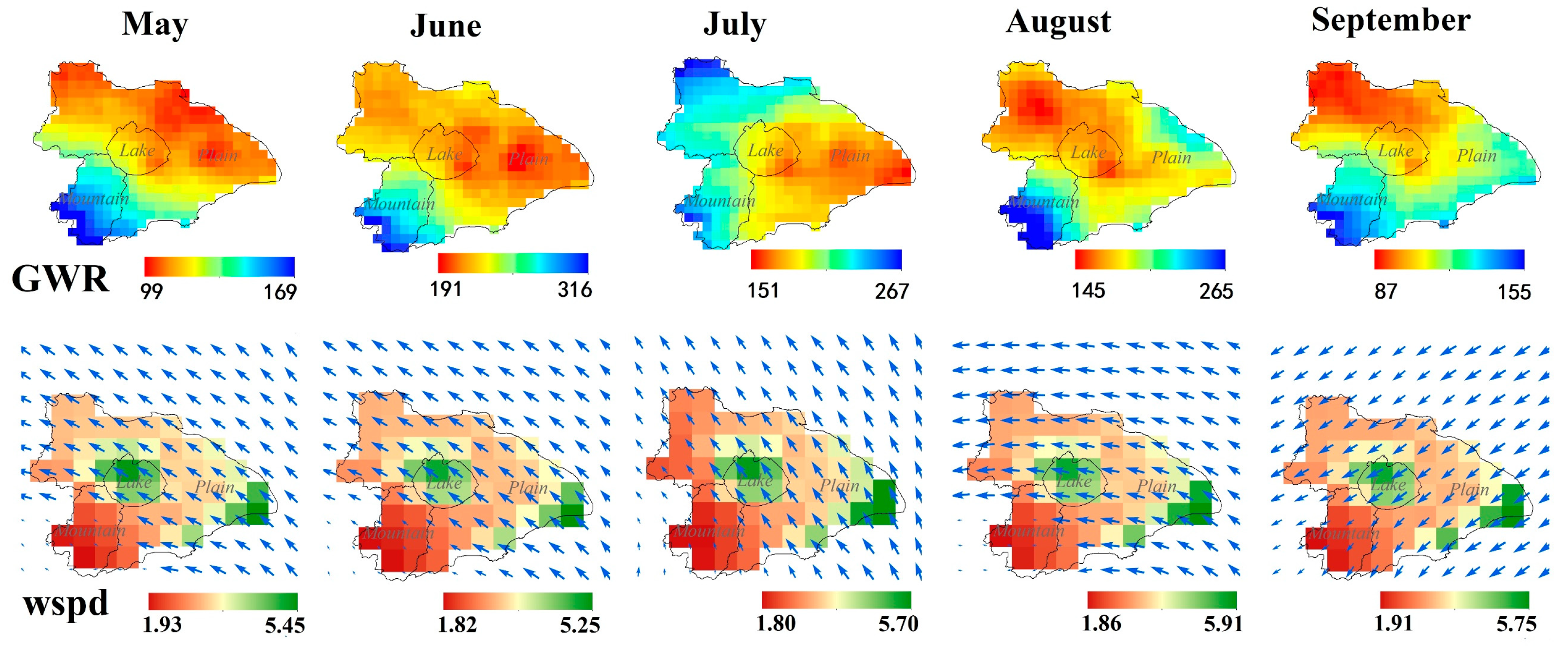
| Precipitation | May | June | July | August | September | Average | |
|---|---|---|---|---|---|---|---|
| Benchmark (mm) | Max | 115.2 | 210.3 | 186.6 | 165.5 | 113.4 | 157.3 |
| Min | 96.8 | 188.6 | 151.2 | 142.9 | 88.0 | 136.8 | |
| Mean | 105.2 | 198.1 | 163.6 | 152.1 | 97.0 | 143.2 | |
| MSWEP V2.1 (mm) | Max | 93.7 | 182.1 | 157.2 | 129.9 | 81.4 | 127.7 |
| Min | 69.1 | 141.0 | 114..6 | 99.8 | 63.1 | 97.8 | |
| Mean | 81.9 | 164.2 | 139.7 | 116.7 | 73.9 | 115.3 | |
| GWRMP (mm) | Max | 125.4 | 238.3 | 200.1 | 176.1 | 119.1 | 169.8 |
| Min | 104.4 | 199.6 | 161.2 | 150.3 | 97.1 | 142.6 | |
| Mean | 113.3 | 218.2 | 184.2 | 162.4 | 105.8 | 156.8 | |
| EOF | n | tnorm | DEM | Lat | Lon | DMSP | ||||
|---|---|---|---|---|---|---|---|---|---|---|
| r | t | r | t | r | t | r | t | |||
| EOF-1 | 344 | 2.58 | 0.64 | 15.40 | 0.46 | 9.58 | 0.58 | 13.17 | 0.37 | 7.37 |
| EOF-2 | 344 | 2.58 | 0.20 | 3.77 | 0.96 | 66.08 | 0.34 | 6.69 | 0.001 | 0.02 |
| EOF-3 | 344 | 2.58 | 0.37 | 7.37 | 0.23 | 4.37 | 0.90 | 37.53 | 0.52 | 11.26 |
| EOF-4 | 344 | 2.58 | 0.07 | 1.30 | 0.05 | 0.93 | 0.22 | 4.17 | 0.27 | 5.19 |
| Divisions | r | n | t | tnorm |
|---|---|---|---|---|
| Lake upwind less rainfall area | 0.171 | 55 | 1.26 | 2.68 |
| Plain moderate rain area | 0.197 | 215 | 2.93 | 2.58 |
| Mountain rainy area | 0.644 | 74 | 7.14 | 2.66 |
© 2020 by the authors. Licensee MDPI, Basel, Switzerland. This article is an open access article distributed under the terms and conditions of the Creative Commons Attribution (CC BY) license (http://creativecommons.org/licenses/by/4.0/).
Share and Cite
Zhao, J.; Yang, L.; Li, L.; Wang, L.; Hu, Q.; Wang, Y. Analysis of the Lake-Effect on Precipitation in the Taihu Lake Basin Based on the GWR Merged Precipitation. Water 2020, 12, 180. https://doi.org/10.3390/w12010180
Zhao J, Yang L, Li L, Wang L, Hu Q, Wang Y. Analysis of the Lake-Effect on Precipitation in the Taihu Lake Basin Based on the GWR Merged Precipitation. Water. 2020; 12(1):180. https://doi.org/10.3390/w12010180
Chicago/Turabian StyleZhao, Jing, Long Yang, Lingjie Li, Lachun Wang, Qingfang Hu, and Yintang Wang. 2020. "Analysis of the Lake-Effect on Precipitation in the Taihu Lake Basin Based on the GWR Merged Precipitation" Water 12, no. 1: 180. https://doi.org/10.3390/w12010180
APA StyleZhao, J., Yang, L., Li, L., Wang, L., Hu, Q., & Wang, Y. (2020). Analysis of the Lake-Effect on Precipitation in the Taihu Lake Basin Based on the GWR Merged Precipitation. Water, 12(1), 180. https://doi.org/10.3390/w12010180





